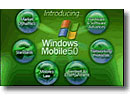Tech Guide: Microsoft ships Windows Mobile 5.0


Three-pronged approach
In developing Windows Mobile 5.0, Microsoft has taken a three-pronged approach that focuses on productivity, the multimedia experience and the ability for manufacturers to differentiate their hardware.
With Windows Mobile 5.0, Microsoft addresses many of the productivity issues that hampered its predecessor. Pocket versions of popular applications such as Word and Excel have been replaced by more capable Mobile versions: Word Mobile now supports tables, lists and embedded images, while Excel Mobile allows you to create charts and graphs. There's also PowerPoint Mobile, which although it doesn't let you modify presentations does allow you to view them.
Microsoft has also developed Windows Mobile 5.0 in such a way that hardware manufacturers will be able to create devices in many different form factors, incorporating QWERTY keyboards, landscape display orientation and soft-key integration. There is also support in version 5.0 for a wider range of wireless technologies, such as 3G and Wi-Fi for smart phones, plus improved Bluetooth support.
Persistent storage
Another area where Windows Mobile lagged behind Palm OS was in the realm of persistent storage. Historically, when the battery on a Windows Mobile-based device drained completely, user data was lost. To counter this, Windows Mobile-based devices sometimes allocated up to 30 percent of their battery power just to save data. Windows Mobile 5.0 now has built-in support for persistent storage, so that when the battery drains completely, your data remains intact. This means that you can expect longer battery life, as the device won't have to allocate any power to maintain the information stored on it.
With support for ActiveSync 4.0, Windows Mobile 5.0 now gives you the ability to synchronise wirelessly via Bluetooth. Additionally, devices will support pictures in contacts, as well as many other user-friendly extras.
No Windows Mobile 5.0 devices have yet been announced for the UK, but we expect to see them arriving within the next few months. Stay tuned for previews and reviews of these handhelds and smart phones as they arrive.
| Preview |
| Windows Mobile 2003 Second Edition Microsoft's latest OS for handhelds and smart phones -- Windows Mobile 2003 Second Edition -- adds some attractive features, such as VGA support. |